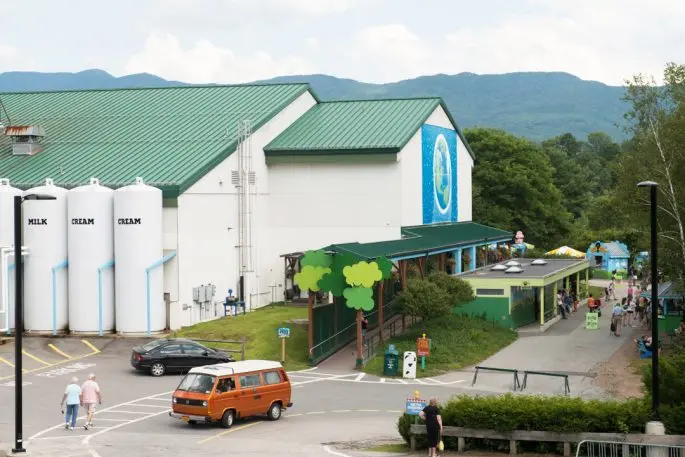As companies increasingly talk about their values and place in society, many managers have started to talk about leading with “purpose.” Ideo designer and doctoral student Nina Montgomery invited several senior executives to share their own experiences navigating the intersection of business and social responsibility; she compiled their essays in a book, Perspectives on Purpose:Leading Voices on Building Brands and Businesses for the Twenty-First Century, which will be released in February. In this excerpt, Rob Michalak, the global director of social impact for Ben & Jerry’s, explains the company’s commitment to “linked prosperity,” the notion that as the business prospers, its community of stakeholders such as suppliers and employees will benefit, too.
You’ve probably heard of Ben and Jerry, but you might not know about Bernie. Bernie Glassman, a space-age aeronautical engineer turned Buddhist Zen Master, had a bakery in Yonkers, New York by the name of Greyston Bakery. From its start, Greyston was a local, purpose-driven business making wonderful cakes for high-end restaurants in the New York City area. Greyston did things a bit differently from most. It hired people with barriers to employment–a practice it called open hiring–and its application process required no resume. They cared not about who you were yesterday, but rather about who you are today, and who you could be tomorrow.

The first shipments of brownies were baked in Yonkers, but hastily packed before cooling properly. By the time they arrived in Vermont, what had been brownie wafers had melded into two tons worth of fifty-pound brownie blocks. Those weren’t going to be easy to turn into ice cream sandwiches. So, it was time for a little resourceful innovation. Instead of sending the brownies back to Greyston (which really couldn’t afford the loss of a shipment that size at the time), the Ben & Jerry’s team started chipping the brownie blocks into brownie chunks that could be mixed into a pint of ice cream.
And with that, Ben & Jerry’s Chocolate Fudge Brownie was born.
The flavor sold well, which meant Ben & Jerry’s soon needed more brownies. More brownies meant more bakers, allowing Greyston to hire and train more people from the Yonkers community who couldn’t otherwise find jobs. Between 1990 and 2018, Greyston created over three thousand brownie-baking jobs, generating about $65 million in payroll and providing benefits to about 19,000 families through the Greyston Foundation.
Imagine saving the world through chocolate brownies and ice cream. Hyperbole? Well, maybe. But even if we’re not saving the world, the humble brownie is a great example of what is at the center of Ben & Jerry’s purpose-driven business model, which, when done well, can create a lot of good.

The Greyston Bakery story is a great example of the Ben & Jerry’s business model in action. As we see it, there are three core pillars of our business: We serve the first pillar, our product mission, by making a great flavor (in this case, Chocolate Fudge Brownie). The second pillar, our economic mission, is achieved through high sales numbers (special thanks to our many fans who have loved and bought this flavor over the years!). And the third pillar, our social mission, is accomplished in this case through Greyston’s hiring of more people with barriers to employment and contributing to families within the community.
These three pillars–product, economic, and social–hold up our business model vision: we are dedicated to a sustainable corporate concept of “linked prosperity.” The idea is as simple as it is radical. As a company prospers, all those touched by the company must also prosper, including employees, suppliers, customers, communities, and everyone else within our value chain.

In addition to these corporate policies and practices, we see our franchised scoop shop model as allowing Ben & Jerry’s to deliver on linked prosperity at a more local level: locally-committed owner-operators are empowered to engage with their communities and foster mutually beneficial relationships. Each year, Ben & Jerry’s scoop shops help to raise money for local charities but also actively engage in providing direct benefits to the community through a variety of activities. On one special day in the spring of each year, Ben & Jerry’s scoop shops globally celebrate their local communities on Free Cone Day. The day creates important levels of awareness for local non-profits and raises tens of thousands of dollars for local charities, not to mention provides about two million free scoops of ice cream to our fans, whom we deeply appreciate all year ’round.
You might be thinking, “That’s a nice idea, but at the end of the day, business is business:does this linked prosperity business model actually work?” To that I’d say a resounding yes: doing good for the community is also good for business. We know that people have deeper, more loyal connections to businesses that have shared values. We see this in the successful companies that are growing the certified B Corp movement. They will stick with those companies longer, through good and bad times, helping to smooth out rough patches along the way. We’ve seen that through the dramatic moments in the global economy of the recent past. Our internal research supports this, telling us that Ben & Jerry’s fans who know and understand our values-led business model are more than twice as loyal than those who don’t know about it. The Millennial generation in particular favors authentic, purpose-driven businesses, and its members are twice as loyal to us as they are to other companies. The next generation up, Generation “Z” (or “Zennials,” as some cleverly call them) are demanding even more from purpose-driven businesses and expect authentic, transparent relationships with the businesses they will support.
Linked prosperity is a business model. It’s not public relations. And it’s not philanthropy. This means as we continue to grow our business, we will continue to grow our social impact. And that’s something pretty awesome.
Excerpted from Perspectives on Purpose: Leading Voices on Building Brands and Businesses for the Twenty-First Century, edited by Nina Montgomery with permission of Routledge, a member of Taylor & Francis Group. Copyright © 2019.
Recognize your brand’s excellence by applying to this year’s Brands That Matter Awards before the early-rate deadline, May 3.
